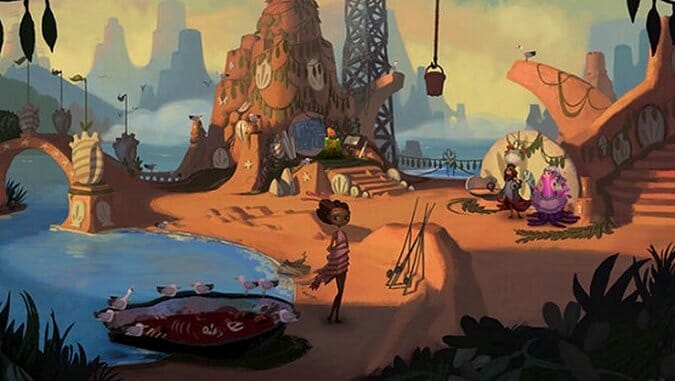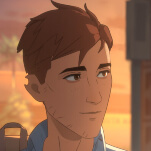Broken Age: Act Two—Second Half Slump

There’s a scene in Broken Age: Act 2 involving a character who has based its entire existence around having created a problem for itself. The problem—as the character sees it, anyway—has an extremely specific solution, and when that solution becomes unavailable the character and its friends wind up inconsolable. While the game’s protagonist does her best to propose various stopgaps, up to and including reminding the characters that they’re in a prison of their own design, nothing will do. “Please think about these solutions before you present them!” the character exhorts, in between sobs of despair. Eventually, the flimsiest possible facsimile of the character’s solution slips by it and its friends undetected. All involved parties have a great time as a result.
In a way, then, the crying character had the right idea; manufacturing problems with ridiculous, arcane solutions can be a win-win. As long as you don’t mind being despondent or embarrassed while your concerns are not properly addressed, you get to blame the universe if things don’t work out. If things go your way, however, you’re allowed the tangy euphoria of getting exactly what you want, on your terms.
Which brings me to adventure games.
Point-and-click adventures like Broken Age know exactly what they want. They present impossibly convoluted situations and give the player the opportunity and raw materials to sort things out. (One of the most diabolical puzzles in Act Two consists of untying a really complicated knot.) The player is given the satisfaction of basically reading the game’s mind, and of having solved a very specific, tangible problem. The game (and by extension, I guess, the game’s designer) is afforded that aforementioned tangy euphoria.
I’ve never quite understood gripes about the hilariously implausible solutions adventure games dictate for their puzzles. There’s no objective level of insanity that the puzzles occasionally cross; the extent to which a puzzle is bad is just a function of how much it takes the player out of being absorbed in the rest of the game. Suspension of disbelief—being willing to submit oneself whole hog to adventure games’ hairbrained versions of reality—is what makes them so fun. Would walking Gabriel Knight to a costume shop to buy a fake mustache have made for a better game? Guybrush Threepwood, with his self-awareness and tendency towards nonviolence, would have made a terrible pirate. Ben and his Polecats opted for Full Throttle’s electric bunnies and fake IDs instead of methamphetamine and unlicensed firearms, thank God.
By the same token, the worlds and narratives in these games are weird, detailed and internally cohesive enough that their “reality” transcends both the perennial shoddiness of their protagonists’ fake mustaches and their utter unwillingness to talk to anyone about their increasingly absurd problems. The way the worlds of games like this can ring true trumps the fact that, as systems, they come off like total whiny babies. On some level, almost every single one of my friends reminds me of at least one of Day of the Tentacle’s three main characters.
Considering it’s literally split across two games, it’s a given that Broken Age lacks a certain amount of this internal cohesion. Taken as one work, though, Broken Age still feels conflicted about its two-act structure, and the fact that its division was primarily a business decision tends to show despite Double Fine’s best efforts.
-

-

-

-

-

-

-

-

-

-

-

-

-

-

-

-

-

-

-

-

-

-

-

-

-

-

-

-

-

-

-

-

-

-

-

-

-

-

-

-









































